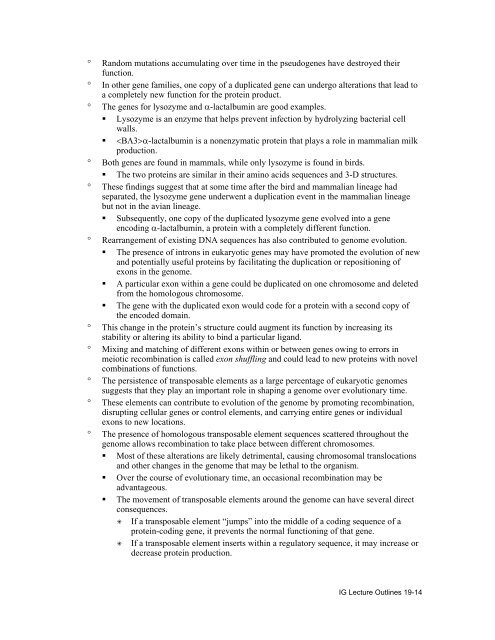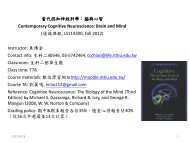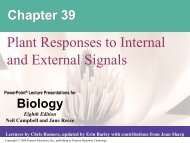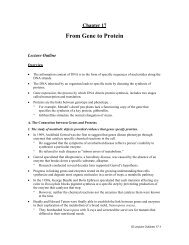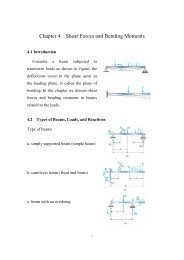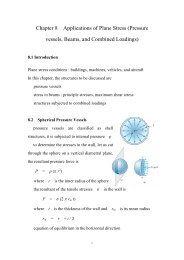chapter 19 the organization and control of eukaryotic genomes
chapter 19 the organization and control of eukaryotic genomes
chapter 19 the organization and control of eukaryotic genomes
Create successful ePaper yourself
Turn your PDF publications into a flip-book with our unique Google optimized e-Paper software.
° R<strong>and</strong>om mutations accumulating over time in <strong>the</strong> pseudogenes have destroyed <strong>the</strong>irfunction.° In o<strong>the</strong>r gene families, one copy <strong>of</strong> a duplicated gene can undergo alterations that lead toa completely new function for <strong>the</strong> protein product.° The genes for lysozyme <strong>and</strong> α-lactalbumin are good examples.• Lysozyme is an enzyme that helps prevent infection by hydrolyzing bacterial cellwalls.• α-lactalbumin is a nonenzymatic protein that plays a role in mammalian milkproduction.° Both genes are found in mammals, while only lysozyme is found in birds.• The two proteins are similar in <strong>the</strong>ir amino acids sequences <strong>and</strong> 3-D structures.° These findings suggest that at some time after <strong>the</strong> bird <strong>and</strong> mammalian lineage hadseparated, <strong>the</strong> lysozyme gene underwent a duplication event in <strong>the</strong> mammalian lineagebut not in <strong>the</strong> avian lineage.• Subsequently, one copy <strong>of</strong> <strong>the</strong> duplicated lysozyme gene evolved into a geneencoding α-lactalbumin, a protein with a completely different function.° Rearrangement <strong>of</strong> existing DNA sequences has also contributed to genome evolution.• The presence <strong>of</strong> introns in <strong>eukaryotic</strong> genes may have promoted <strong>the</strong> evolution <strong>of</strong> new<strong>and</strong> potentially useful proteins by facilitating <strong>the</strong> duplication or repositioning <strong>of</strong>exons in <strong>the</strong> genome.• A particular exon within a gene could be duplicated on one chromosome <strong>and</strong> deletedfrom <strong>the</strong> homologous chromosome.• The gene with <strong>the</strong> duplicated exon would code for a protein with a second copy <strong>of</strong><strong>the</strong> encoded domain.° This change in <strong>the</strong> protein’s structure could augment its function by increasing itsstability or altering its ability to bind a particular lig<strong>and</strong>.° Mixing <strong>and</strong> matching <strong>of</strong> different exons within or between genes owing to errors inmeiotic recombination is called exon shuffling <strong>and</strong> could lead to new proteins with novelcombinations <strong>of</strong> functions.° The persistence <strong>of</strong> transposable elements as a large percentage <strong>of</strong> <strong>eukaryotic</strong> <strong>genomes</strong>suggests that <strong>the</strong>y play an important role in shaping a genome over evolutionary time.° These elements can contribute to evolution <strong>of</strong> <strong>the</strong> genome by promoting recombination,disrupting cellular genes or <strong>control</strong> elements, <strong>and</strong> carrying entire genes or individualexons to new locations.° The presence <strong>of</strong> homologous transposable element sequences scattered throughout <strong>the</strong>genome allows recombination to take place between different chromosomes.• Most <strong>of</strong> <strong>the</strong>se alterations are likely detrimental, causing chromosomal translocations<strong>and</strong> o<strong>the</strong>r changes in <strong>the</strong> genome that may be lethal to <strong>the</strong> organism.• Over <strong>the</strong> course <strong>of</strong> evolutionary time, an occasional recombination may beadvantageous.• The movement <strong>of</strong> transposable elements around <strong>the</strong> genome can have several directconsequences. If a transposable element “jumps” into <strong>the</strong> middle <strong>of</strong> a coding sequence <strong>of</strong> aprotein-coding gene, it prevents <strong>the</strong> normal functioning <strong>of</strong> that gene. If a transposable element inserts within a regulatory sequence, it may increase ordecrease protein production.IG Lecture Outlines <strong>19</strong>-14


